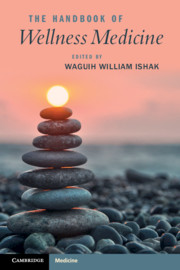Book contents
- The Handbook of Wellness Medicine
- The Handbook of Wellness Medicine
- Copyright page
- Dedication
- Contents
- Contributors
- Part I Approach to Wellness
- Part II From Illness to Wellness by Organ Systems/Disorders
- Chapter 6 The Concept of Wellness in Psychiatric and Substance-Use Disorders
- Chapter 7 Neurological and Neurosurgical Disorders and Wellness
- Chapter 8 Cardiovascular and Pulmonary Wellness
- Chapter 9 Gastrointestinal System and Wellness
- Chapter 10 Wellness and the Genito-Urinary System
- Chapter 11 Reproductive System
- Chapter 12 Allergic, Infectious, and Immunological Processes
- Chapter 13 Wellness in Endocrine and Metabolic Disorders
- Part III Special Populations and Special Topics
- Part IV Wellness Interventions
- Part V Wellness through Optimization of Work, Love, and Play
- Book part
- Index
- References
Chapter 7 - Neurological and Neurosurgical Disorders and Wellness
from Part II - From Illness to Wellness by Organ Systems/Disorders
Published online by Cambridge University Press: 18 September 2020
- The Handbook of Wellness Medicine
- The Handbook of Wellness Medicine
- Copyright page
- Dedication
- Contents
- Contributors
- Part I Approach to Wellness
- Part II From Illness to Wellness by Organ Systems/Disorders
- Chapter 6 The Concept of Wellness in Psychiatric and Substance-Use Disorders
- Chapter 7 Neurological and Neurosurgical Disorders and Wellness
- Chapter 8 Cardiovascular and Pulmonary Wellness
- Chapter 9 Gastrointestinal System and Wellness
- Chapter 10 Wellness and the Genito-Urinary System
- Chapter 11 Reproductive System
- Chapter 12 Allergic, Infectious, and Immunological Processes
- Chapter 13 Wellness in Endocrine and Metabolic Disorders
- Part III Special Populations and Special Topics
- Part IV Wellness Interventions
- Part V Wellness through Optimization of Work, Love, and Play
- Book part
- Index
- References
Summary
Neurological and neurosurgical disorders represent a particularly salient area for interventions using practices of wellness medicine. Due to the complex physiology and functions of the nervous system, disease processes can have a wide range of clinical presentations, each with unique hardships. Because the nervous system itself provides individuals with cognition, sense of self, and identity, the loss of normal neurological function in day-to-day activities can elicit substantial emotional distress. Neurological disorders are also somewhat unique in that a large number of conditions lack curative treatments and require lifelong symptom management and supportive care [1]. Medical and surgical interventions for such diseases often come with their own set of complications, side effects, and impacts on quality of life [2]. It is therefore important for care providers to understand the ways in which patients can improve their health by seeking personalized cognitive, behavioral, physical, and spiritual interventions alongside their standard course of treatment.
- Type
- Chapter
- Information
- The Handbook of Wellness Medicine , pp. 66 - 78Publisher: Cambridge University PressPrint publication year: 2020

